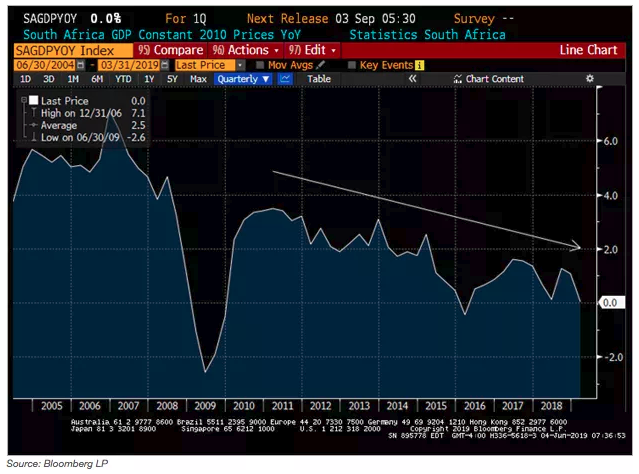By Natalia Gurushina, VanEck Economist, Emerging Markets Fixed Income
South Africa’s growth woes bring back discussions about changing the central bank’s mandate. The market increasingly prices in policy rate cuts in Latin America (LATAM), as activity indicators continue to disappoint.
A big downside surprise in South Africa’s Q1 gross domestic product (GDP) pushed the rand down by 172bps in the morning trade (as of 9:28am, according to Bloomberg LP). The yearly growth was flat in real terms, contrary to expectations of a small expansion (0.6% year-on-year). This is a significant slowdown compared to the previous quarter (1.1% year-on-year, see chart below), and the latest activity surveys—the Absa Manufacturing PMI dropped to 45.4 in May—suggest that the weakness might continue in Q2 before showing signs of stabilization in H2. Today’s release is an argument in favor of a policy rate cut in July. However—and more worryingly—it also resurrected discussions about changing the central bank’s mandate to target growth and jobs.
The weak growth environment in Brazil presents a headache for the central bank, which was reflected in the governor’s interview with local newspaper Valor yesterday. Industrial production undershot consensus in April, contracting by 3.9% year-on-year. Even though the weakness was mainly due to disruptions in the mining sector, the risks to GDP growth remain to the downside, and this started to feed into the market expectation of 51bps of rate cuts in Brazil over the next six months.
The market expectations for rates in the U.S. remain extremely dovish, and today’s macro releases did nothing to change the status quo. New factory orders in the U.S. continued to look tepid in April, expanding by mere 1% on a yearly basis, and the regional Federal Reserves (Fed) latest GDP nowcasts suggest that economic growth will stay below 1.5% in Q2. It is hardly surprising that today’s comments by Fed Chairman Powell—especially the bit about acting appropriately to sustain the expansion—were seen through the dovish lens.

Absa Manufacturing PMI for South Africa is compiled by the Bureau for Economic Research (BER), sponsored by Absa, and is based on the Purchasing Managers Index (PMI) produced by the Institute for Supply Management (ISM) in the U.S
IMPORTANT DEFINITIONS & DISCLOSURES
PMI – Purchasing Managers’ Index: economic indicators derived from monthly surveys of private sector companies; ISM – Institute for Supply Management PMI: ISM releases an index based on more than 400 purchasing and supply managers surveys; both in the manufacturing and non-manufacturing industries; CPI– Consumer Price Index: an index of the variation in prices paid by typical consumers for retail goods and other items; PPI – Producer Price Index: a family of indexes that measures the average change in selling prices received by domestic producers of goods and services over time; PCE inflation – Personal Consumption Expenditures Price Index: one measure of U.S. inflation, tracking the change in prices of goods and services purchased by consumers throughout the economy; MSCI – Morgan Stanley Capital International: an American provider of equity, fixed income, hedge fund stock market indexes, and equity portfolio analysis tools; VIX – CBOE Volatility Index: an index created by the Chicago Board Options Exchange (CBOE), which shows the market’s expectation of 30-day volatility. It is constructed using the implied volatilities on S&P 500 index options.; GBI-EM – JP Morgan’s Government Bond Index – Emerging Markets: comprehensive emerging market debt benchmarks that track local currency bonds issued by Emerging market governments.; EMBI – JP Morgan’s Emerging Market Bond Index: JP Morgan’s index of dollar-denominated sovereign bonds issued by a selection of emerging market countries; EMBIG – JP Morgan’s Emerging Market Bond Index Global: tracks total returns for traded external debt instruments in emerging markets.
The information presented does not involve the rendering of personalized investment, financial, legal, or tax advice. This is not an offer to buy or sell, or a solicitation of any offer to buy or sell any of the securities mentioned herein. Certain statements contained herein may constitute projections, forecasts and other forward looking statements, which do not reflect actual results. Certain information may be provided by third-party sources and, although believed to be reliable, it has not been independently verified and its accuracy or completeness cannot be guaranteed. Any opinions, projections, forecasts, and forward-looking statements presented herein are valid as the date of this communication and are subject to change.
Investing in international markets carries risks such as currency fluctuation, regulatory risks, economic and political instability. Emerging markets involve heightened risks related to the same factors as well as increased volatility, lower trading volume, and less liquidity. Emerging markets can have greater custodial and operational risks, and less developed legal and accounting systems than developed markets.
All investing is subject to risk, including the possible loss of the money you invest. As with any investment strategy, there is no guarantee that investment objectives will be met and investors may lose money. Diversification does not ensure a profit or protect against a loss in a declining market. Past performance is no guarantee of future performance.
![]()







